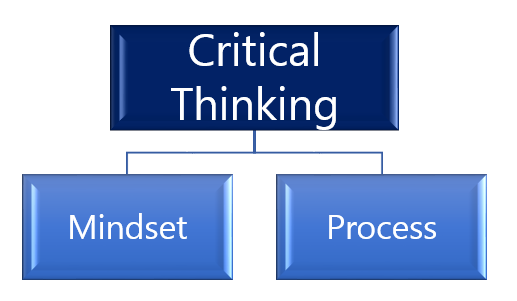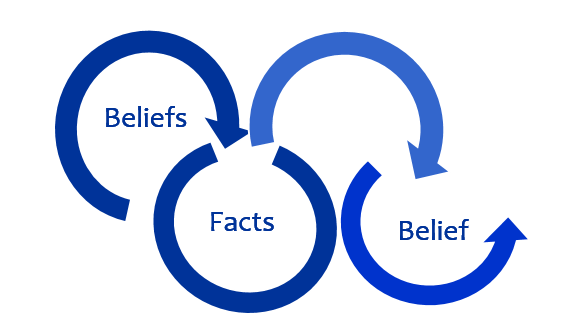A critical thinker is someone who will gather relevant information in order to systematically and open-mindedly analyze issues from a wide variety of perspectives to reach a well-reasoned conclusion.
How To Become a Critical Thinker
Becoming a critical thinker is not just about completing specific steps in a process, but also about having the right mindset. To become a critical thinker, you need to be open-minded, able to embrace multiple perspectives, and willing to change your beliefs. With the correct mindset, you can begin the process of critically thinking. That process includes gathering information, evaluating the information, asking questions, formulating ideas, drawing conclusions.
Critical Thinker’s Mindset
Before you begin the critical thinking process, you have to develop the right mindset. Without the right mindset, all the other steps for critical thinking are rendered useless. The ability to let your personal biases go and arrive at a conclusion based on all of the information is central to the critical thinking process.
Become Open-minded
To become a critical thinker, you have to learn to be open-minded. Unfortunately, most people have a subconscious bias that influences how they think about certain topics, people, or situations. Their reactive mindset is not intentional, but can influence their thought process.
People can have what is called confirmation bias. This subconscious tendency can cause them to interpret information in a way that confirms or supports their existing beliefs while ignoring information that does not conform to their beliefs. People display this bias when they only select information that supports their views, while ignoring any information to the contrary. They are not critically thinking by giving greater credence to evidence that fits with their existing beliefs.
Basically, confirmation bias is interpreting the information to fit your beliefs, while critical thinking is adjusting your mindset and beliefs to fit the facts. Therefore, to be an effective critical thinker you must embrace open-mindedness.
Consider Multiple Perspectives
To be a critical thinker, you need to consider multiple points of view. Only getting one perspective will severely limit your ability to fully assess the information. However, by considering multiple perspectives and alternative possibilities, you are able to get a fuller grasp of the information and understand how it affects other variables.
Become Open to Change
As a critical thinker, you need to be willing to change your mind if you discover you were wrong. Even though you may be open to hear other viewpoints, if you are not willing to change your mind when presented with solid evidence, you are not critically thinking. Some of the best critical thinker, are not just willing to change their minds, but looking to change their minds. They look for valid evidence that is counter to what they currently believe.
Steps in the Critical Thinking Process
As mentioned, to become a critical thinker it is both a mindset and a process. After you have adopted an open-mind and are flexible to change beliefs, you can begin the process of critically analyzing information. The steps include the following:
- Gathering information
- Separating fact from opinion
- Judging validity
- Evaluating the information
- Formulating ideas
- Asking questions
- Drawing conclusions
Gather Information
In order to be critical thinker, you need to have enough information to analyze. That starts with the ability to gather data from multiple sources. Not only do you want multiple sources, but you also want those sources to have various perspectives.
Separate Fact from Opinion
After you have gathered the necessary information, you need to separate facts from opinions. A critical thinker needs to understand what is fact and what is opinion. Opinions can be useful insight, but conclusions must be drawn from and supported by facts.
Judge the Validity
After you gather and sort the information, you need to judge the validity of that evidence. Assess the validity of arguments, ideas, and facts in order to form a fair and unbiased opinion. Although you sort facts from opinions, you need to look at where the information has come from. Even though they proport to be facts, the information can be made up or misleading. You need to determine if it is a trustworthy source and find out what is their motivation for presenting this information.
Evaluate the Information
After you have sorted and assessed the information for quality, you need to evaluate it. This is where you take a close look at the data you have collected and examine it for context and meaning. Make sure you use logic and reasoning to evaluate the information. Keep in mind that not all data is made equal. Some information is supported by extensive research and some is just an opinion. Although opinion can be helpful to get various perspectives and fill in gaps in the data, it would need to match up with the facts. That way, you can draw the best conclusions from the data you have collected.
Formulate Ideas
As you are examining the information, you what to formulate ideas. Look beyond what has been presented and think deeper about potential connections as well as cause and effect.
Ask Questions
In order to be an effective critical thinker, you need to question ideas and assumptions rather than accepting them at face value. When presented with a piece of new information, ask questions such as;
“What is the source of this information?”
“What was the reason for this information?”
“What information supports this?”
“How do we know the information is valid?”
“Does this information logically match with other information?”
Draw Conclusions
The final step in the process is to make conclusions on the information. The conclusions should be based on evidence that has been supported by logic and facts.
Types of Thinking
Chunking as a Learning Strategy


